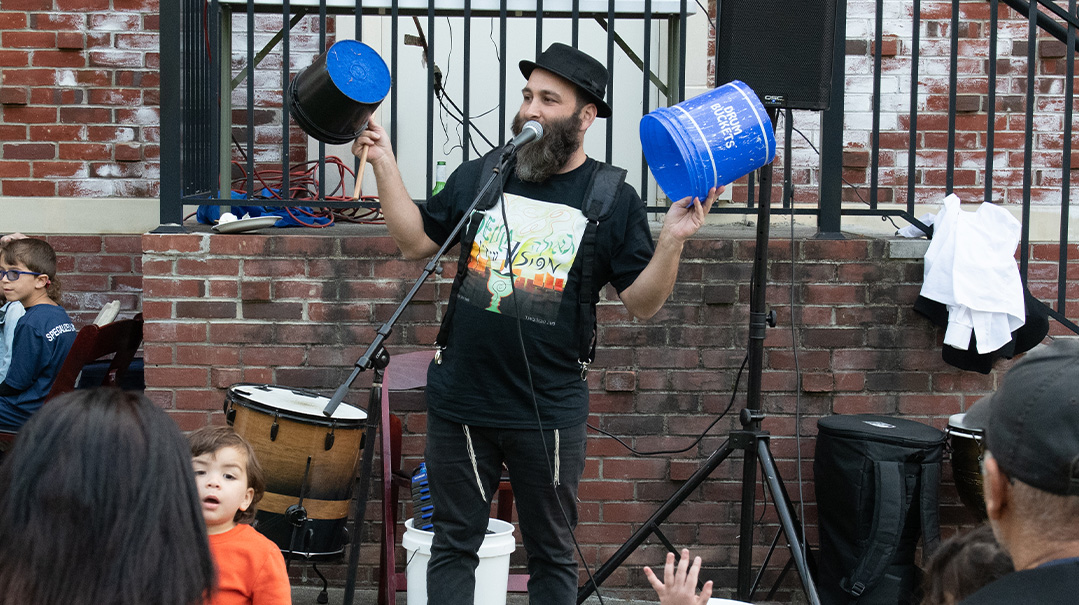A Different Drummer

A meandering musical journey gave Moshe Sobol's spirit new rhythm

Photos: Jeff Zorabedian
AN
affable-looking man in his forties pulls up to the New Jersey shul’s parking lot. The trailer attached to his gray Nissan Quest is filled with 75 padded black cases, each one protecting a small hand drum. After confirming where to set up, he and his 15-year-old daughter proceed to unload the drums. They unsheathe each one, spreading them all out on the ground in a large pile to the side of what will be the performance area on this sunny weekend afternoon.
The atmosphere here is festive as families enjoy the Chabad of Greater Monmouth’s Sunday retreat. The lawn is covered with blow-up kiddie slides and tunnels, and in a space nearby, folding chairs are set up in a semicircle. Out in the parking lot, burgers and chicken tenders sizzle over a grill next to long tables heaped with fries, salads, and rice. There’s a station for cotton candy and another for make-your-own-s’mores. Kids and parents eat, play, and enjoy the sunshine while a couple of bochurim dressed as clowns circulate among the crowd.
As the adults eat their fill and the kids get their energy out, the driver — here to provide the event’s entertainment — takes in the scene. But before he starts what’s been billed as, “an interactive drum circle led by percussionist Moshe Sobol,” the star of the show has one final preparation: his getup. He had arrived clad in a white shirt, and now, like Superman, he whisks it off for the gig, transforming into his musician avatar with a dark T-shirt. Moshe dons a small black fedora and he is ready to go.
“Everyone welcome world-renowned drummer Moshe Sobol!” shaliach Rabbi Yosef Carlebach calls out to the attendees. They sit, and following his cue, Moshe steps forward to take command of his spot of lawn facing the crowd.
He begins by telling them a little about percussion, doing a brief show-and-tell of instruments including a tambourine, a guiro (a notched gourd played with a stick), a cowbell, agogo bells (metal, cone-shaped), an overturned bucket, and a melodica (a keyboard played by blowing air through a tube). Then he practices rhythm with the crowd.
“I’ll clap four times, then you clap,” he says. “Now clap after five times… okay!”
Finally it’s time to try out rhythm with their own instruments.
“Everybody take a drum!” Moshe says, gesturing to the collection of colorful djembe drums laid out on the grass. Djembe drums, which originated in West Africa, are popular worldwide because — like a darbouka — you can play them with your bare hands and they can achieve a range of pitches. Each drum is goblet-shaped with a leather-top surface, a wooden base, and vertical tuning ropes.
Once his audience is seated again on their folding chairs, Moshe resumes his instruction.
“We’re going to have some fun!” he announces, after which he demonstrates how to make a low tone by tapping the middle of the drum, and a high tone by tapping the edge. The crowd practices, then follows his example of tapping.
Boom chick-a chick-a boom chick-a chick.
“Everybody beat your drums, one-two, one-two!” Moshe calls. He takes out the melodica, and once the kids are tapping out a beat, plays a Chabad niggun, showing them how their drumming gives verve to the song.
The kids are really into it — their attention is rapt, their enthusiasm contagious. The eight year old with a bowl haircut next to me looks like he’s usually a handful, but he doesn’t take his eyes off Moshe as he slaps his drum and zealously follows every cue.
Next is “Am Yisrael Chai,” followed by a little Jewish rap Moshe composed. The performance is fast-paced, and before you know it, he is inviting children to come up one at a time and perform with him.
“Jump whenever I hit my drum,” he instructs.
He finishes with a bang, singing a high-energy “L’shanah haba’ah” before concluding with a final burst of ten powerful beats.
These performances takes a lot of energy, and Moshe admits he’s usually tired afterward. But he’s happy to speak the next morning about his music and his journey. After all, Moshe Sobol is much more than a kiddie entertainer. He’s a serious musician and music therapist whose goals are to use music to help others, inspire joy, and take Jewish music to the next level.
Oops! We could not locate your form.







